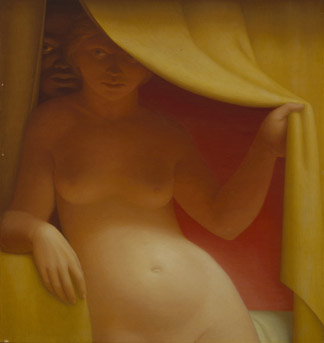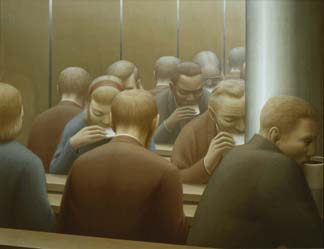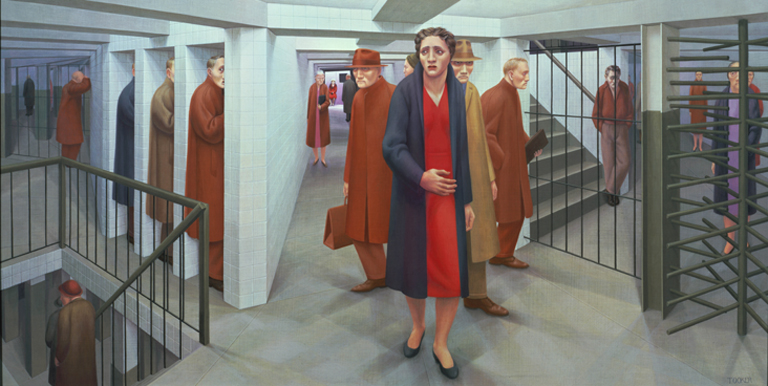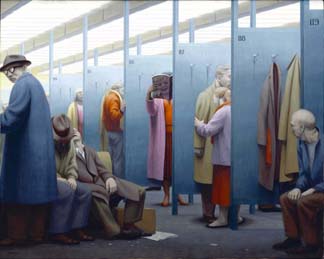
(845) 246-6944 ·
info@ArtTimesJournal.com
|
|
at the National Academy Museum
By RAYMOND J.
STEINER
ART TIMES October 2008
Co-curated
by members from three institutions — the National Academy Museum,
the Pennsylvania Academy of the Fine Arts, and the Columbus Museum of
Art, the three separate Museums have mounted a traveling exhibition which
begins in NYC (see below for schedule) — the full-color catalogue,
along with curator statements, features an essay by Thomas H. Garver,
the author of an earlier book on Tooker, George Tooker, Rizzoli
International Publications, Inc. 1987 (reviewed in our pages in our Jan/Feb
1988 Issue and since re-issued by Pomegranate Communications, Inc. in
1992 and Chameleon Books, Inc. in 2002). In both books, valiant efforts
are made to “pigeonhole” the work of George Tooker, but, as in the case
of most artists, such defining is difficult — and especially when
defining one that gives fair warning by stating outright, “we’re all complex”.
 “Window VII”, 1963 egg tempera on gesso panel 24 1/8 x 21 1/8 in (61.3 x 53.7 cm) Terra Foundation for American Art, Daniel J. Terra Collection 1992.168 |
George
Tooker was one among many of that generation of artists who, coming from
academic backgrounds, suddenly felt themselves caught up — if not
overwhelmed — by the onslaught of what many refer to as “modernism”.
The hardier ones, those more rooted in the concept of art being a “passed-down
craft” of skills —artists, for example, like Paul Cadmus, Jack Levine,
Isobel Bishop, Reginald Marsh, Will Barnet and, of course, George Tooker,
among others — never really buckled under to the pressure of embracing
innovation for its own sake or on its own terms. This, in spite of arguments
by many who, feeling the work of these artists was too important to sweep
under the rug of art history, contorted their “critiques” into facile
apologies claiming that — well — underneath the apparent figurative
realism — artists like Cadmus, Tooker, Bishop, or their like, were
really “closet modernists”, artists who “fitted in” all along.
This is not what I heard back in the early ‘80s from Isobel Bishop,
Bernarda Bryson Shahn, Paul Cadmus, and other figurative painters who
I was then meeting with and profiling for ART TIMES. They were
justly proud of their training, their knowledge of Renaissance techniques,
the virtuosity needed in expertly using materials — and all steeped
in a tradition of humanism that they felt an integral part of and indebted
to. All were fairly candid — and vocal — about their unhappiness
with being shunted aside by what they considered less talented if more
publicly vaunted up-comers. Over lunch one day in the Village, Jack Levine
— who could grow incensed by any mention of the “abstract expressionists”
— put it rather bluntly when he said, “I never said that Jackson
Pollock couldn’t draw his hand — I said he couldn’t even trace
it!”
Less
explosive but as intellectually opposed to what was happening to their
craft, Paul Cadmus — serious, reserved, dignified, almost patrician
in his measured judgments and responses to my questions — gave little
quarter to “modernist” tendencies. He once referred to a drawing of a
woman he’d done as a child as his “DeKooning Period”. He kept it hanging
in his living-room/studio.
 “Lunch”, 1964 egg tempera on gesso panel 20 x 26 in. (50.8 x 66 cm) Columbus Museum of Art, Ohio: museum Purchase, Derby Fund, from the Philip J. & Suzanne Schiller Collection of American Social Commentary Art 1930-1970 |
Jack
Levine had recommended Cadmus to be on my short list of candidates for
inclusion in our publication so I’d profiled him in May of 1984 for ART
TIMES. Less than two years out on the stands at the time, we were
already dedicated to what we called the “long view”, ignoring much of
what was being called “cutting edge” since so many arts publications were
already hot on the trail of every newcomer on the scene. Like Levine,
Cadmus became a friend as well as a subject, and on a subsequent visit
to his home/studio in Weston, Connecticut, the subject of the “artworld”
of course came up. However, he rarely spoke about his work directly, knowing,
as most good artists are aware, that art — if it is genuine art
— must speak for itself and needs — indeed, can suffer
no linguistic translation. It was certainly not that he was reticent.
Literate and worldly, Cadmus was always a pleasurable and edifying conversationalist.
It was simply that he, like many of his colleagues, had little respect
for the artist who sought publicity, who eagerly invited journalists and
talked about their art. “They are famous,” he once said, “for being famous.”
When
I asked Cadmus — as I had asked Levine — what artists I ought
to write about, there was no hesitation in his response: “George Tooker,”
he promptly told me.
This
was about twenty years ago, and I regret that the meeting between Tooker
and me never took place. I no longer recall why — Cadmus had contacted
Tooker and set up the possibility — but the arrangements were never
made — either Tooker's or my schedule prevented my taking the trip
to Vermont, and for whatever reasons that followed, we never personally
came face to face. A pity, since it is my habit never to rely on the words
of others — especially when it comes to artists. No two are alike
— can never be alike — and when it came to the old-schoolers
it was important to see them on their own turf, to know them on their
own terms, and not through the eyes of revisionists trying to claim them
as “wannbe modernists” — if only to make them more palatable (and
saleable) to a less-informed art market/public. I recall Cadmus telling
me that Tooker was jealous of his privacy — an observation borne
out by a quote of Tooker’s that Garver uses to open his chapter “On the
Art of George Tooker”, namely, “Painting is a very isolated occupation”.
 Subway, 1950, egg tempera on composition board, 18 1/8 x 36 1/8 in. (46 x 91.8 cm) Whitney Museum of American Art, NY Purchase, with funds from the Juliana Force Purchase Award |
In
the long run, however, it is always the art and not the artist (or critic/historian)
that speaks the loudest — and, as noted above, we have some sixty-six
works on which to attempt some insight into the aesthetic vision of George
Tooker…so perhaps there was never a necessity to make that trip up to
Vermont, after all.
Setting
aside for a moment Tooker’s subject matter, the merest of glances at either
his graphic work or his egg tempera paintings — the medium alone
speaking volumes about the man and the artist — indicates a consummate
perfectionist. He, like his friend Paul Cadmus, takes his time for a work
to germinate, develop, and evolve — Cadmus, in fact, only did a
handful of works each year. A more studied look might then reveal his
sense of composition, color, and chiaroscuro — something he seems
to have imbibed from a careful study of both Pre- and Full-Renaissance
masters. It is when we take the time for an in-depth visual tour of Tooker’s
work, however, that we begin to see just how “complex” he is. Whatever
Tooker is visually conveying (and the opinions are, as they must be, varied),
his work seems “of a piece”, a consistent world vision that, at bottom,
is almost universally disconcerting. If his technique “pleases”, his subject
matter seems consistently ominous. Interpretation of what he is “saying”
depends, of course, on the range and depth of the onlooker — mine
as well as yours — all such interpretations, perhaps, “valid” since
they reflect our genuine responses, but none definitive. Nor can such
interpretations ever be so. In Tooker’s own words (again taken from the
accompanying catalogue in the beginning of Marshall N. Price’s essay,
“From Anxiety to Agape: George Tooker and the Human Condition”) “I believe
Art, as painting, is communication of thought by means of design, form,
and color…” — in short, only as art and not as words.
The only “real” interpretation of a Tooker painting would (might)
be another painting of whatever Tooker is really communicating
by another artist…”all else is commentary”.
All of which is to say — go see this retrospective for yourself.
Whatever you come away with — though it may say more about you than
about George Tooker — you will have immeasurably added to your appreciation
and ken of just what genuine art can do.
I
laud the National Academy Museum, the Pennsylvania Academy of the Fine
Arts, and the Columbus Museum of Art, along with their curators and author
Thomas H. Garver, for sharing with us this most enigmatic of today’s masters.
*George
Tooker by Robert Cozzolino, Marshall N. Price and M. Melissa Wolfe.
Merrell Publishers Ltd. 2008, London and New York, pg. 31.
**
“George Tooker: A Retrospective” Oct 2—Jan 4, ’09: National Academy
Museum, 1083 Fifth Ave., NYC (212-369-4880. The exhibition will then travel
to the Pennsylvania Academy of the Fine Arts, Philadelphia (Jan 30—Apr
5, ‘09) and the Columbus Museum of Art, Ohio (May 1—Sep 6, ;09).
A full-color catalogue is available.
 Waiting
Room, 1957, egg tempera on wood, 24 x 30 in.
Waiting
Room, 1957, egg tempera on wood, 24 x 30 in.